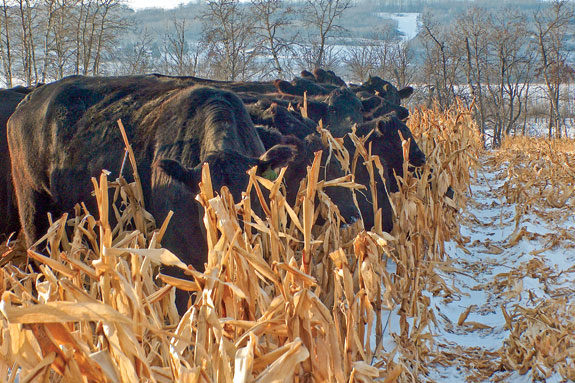MiG increases the length of the growing season of cool-season grasses and legumes, such as tall fescue or most clovers.
However, a very inexpensive winter forage resource often goes unnoticed – feeding crop residues. Allowing beef cattle to graze on cornstalks or soybean stubble after harvest in late fall can extend the grazing season exponentially. Special care must be taken in order to ensure that every animal receives the correct balance of nutrients necessary for efficient production.
Cornstalks are perhaps the most commonly utilized residue crop in the Midwest because of the abundance of fertile land suitable for corn production. It is estimated by Iowa State University that under good weather conditions one acre of cornstalks can provide 30 to 45 days of grazing for a 1,200-pound pregnant cow. Within the grazing period, cows will selectively consume the highest-quality feeds available in the field, such as leftover kernels and leaves. This feed can be up to 70% total digestible nutrients (TDN) with 8 percent protein. After an extended period of time and animal sorting, however, TDN and protein content can be reduced to 40 percent and 5 percent, respectively.
Intensive grazing of this residual crop could increase the length of the grazing period because animals are forced to consume all residual grain and stalks in a paddock before moving on to the next. Using a MiG system for corn residue also reduces the risk of bloating in beef cattle because the animals are not consuming a large amount of corn before moving on to the fibrous stalks.
Protein supplementation for gestating beef cows may be necessary when feeding corn residue, as digestibility will decrease if there are inadequate protein levels in the rumen. In order for the grazing cattle to digest the large amount of fiber found in cornstalks, rumen- degradable protein sources, such as those found in plant proteins, must be supplemented in the diet.
This does not include non-protein nitrogen sources like urea, as they require easily fermentable carbohydrates that can be found in corn kernels.
A practical method of determining the proper time to supplement protein is to inspect the cow manure for the amount of passed corn. When visible levels of digested corn decrease significantly, it is time to begin protein supplementation. This protein supplementation can be administered by feeding 0.5 to one pound of alfalfa hay or oilseed meal per day.
These protein supplements can also include minerals and vitamins that corn residue often lacks, such as calcium, phosphorus and vitamin A. These added nutrients should also be provided for in a free-choice mineral premix throughout the grazing period to reduce the risk of deficiency.
Grazing soybean stubble is also an excellent source of winter forage; however, it has been proven to be less nutritionally adequate as corn crop residue. In fact, cows grazing only bean stubble require about three times the amount of acreage of an animal grazing corn crop residue because of the decrease in available digestible energy.
Soybean stubble does have higher protein content when compared with corn, so grazing a combination of corn and bean residue could be another good option for winter grazing.
Some expenses need to be taken into account if producers are considering grazing crop residues. These include rent for the land being grazed, fencing, water development and labor.
Rent for grazing rights on cropland is generally very low, as they benefit both the grazier and crop producer. The crop producer receives added fertilization of their field from the manure with almost no risk of soil compaction. This risk is low because most grazing will occur after the ground is frozen.
As most fields used for crop production are not fenced in, temporary electric fencing can be used to keep grazing costs to a minimum. Perimeter fences should be at least two wires in case cows begin to test their boundaries when consuming lower-quality feeds just prior to changing paddocks.
Water supply is another large area of concern when grazing on crop residues because the distance an animal travels to a water source should not exceed 800 feet. Typically there are no wells or water sources nearby to serve the herd, and water must be hauled in by the cattle producer.
These issues can be resolved permanently, however, if the cattle producer is willing to make a long-term investment in the crop fields by installing permanent fences and developing a watering system. This is most beneficial if the producer will continuously utilize crop residue for grazing or if they already produce crops.
MiG systems are widely considered to be a vastly advantageous source for animal-harvested feed. By grazing crop residues, the grazing season can be extended exponentially without sacrificing herd health or production levels, particularly in the Midwest with beef cattle. If fencing and watering obstacles can be overcome when feeding corn or bean stubble, this method can greatly reduce production costs and increase the overall profitability for farmers, helping them to reach a goal that all producers share. FG
References omitted due to space but are available upon request.
Editor’s note: Andrea Eilenfeld is a student at Ohio State University.
This article was submitted to the 2010 American Forage and Grassland Council’s “Youth in Grazing Management” essay contest and reprinted here with permission.
PHOTO
It is estimated that under good weather conditions one acre of cornstalks can provide 30 to 45 days of grazing for a 1,200-pound pregnant cow. Photo by FG Staff.












